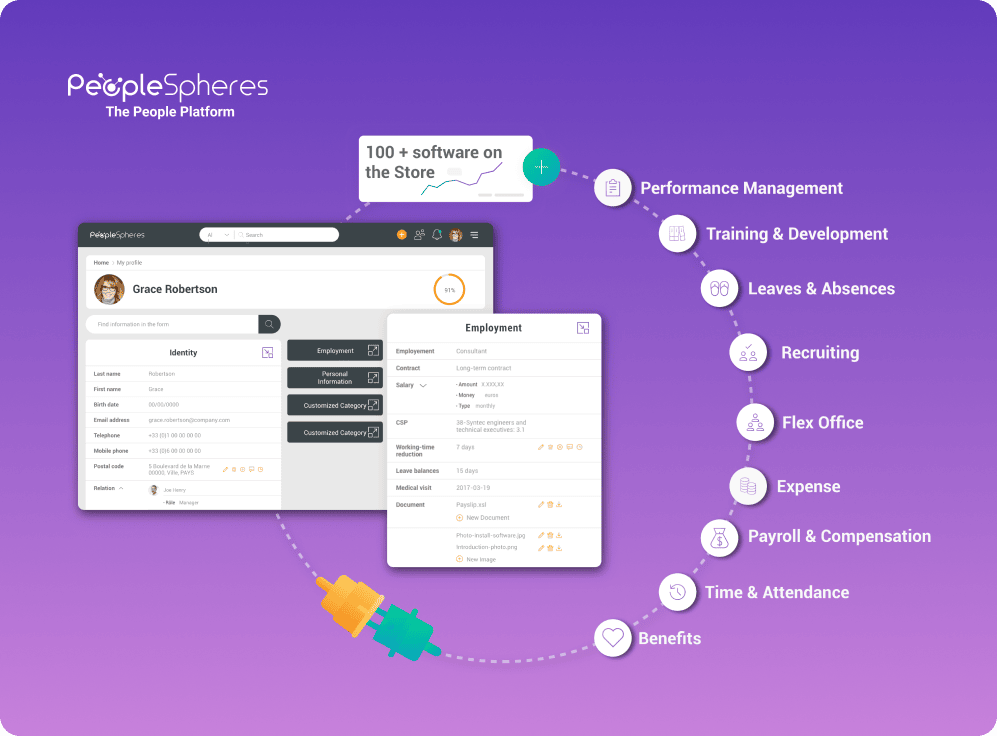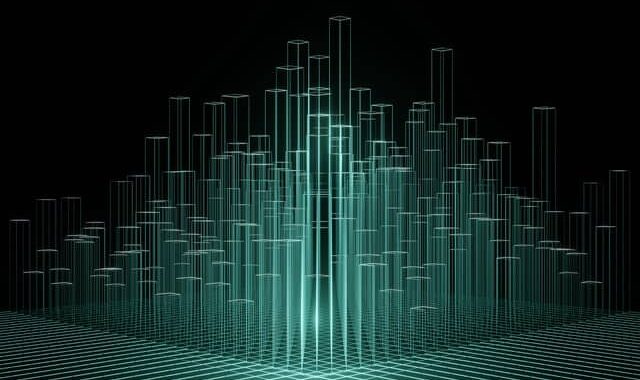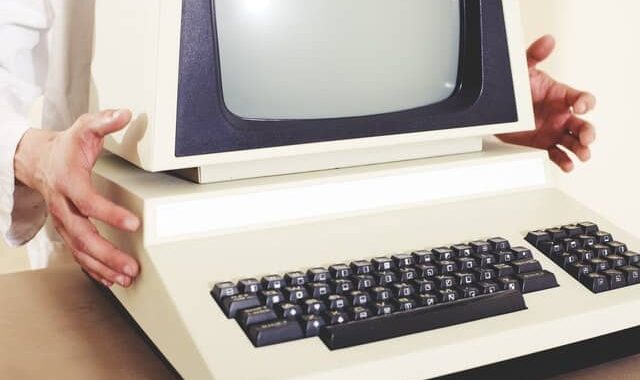
If you’re leading HR at a high-growth company, you’ve probably heard all the hype around Human Resource Information Systems (HRIS). Promised as the “one source of truth” for all your HR needs, an HRIS often comes across as the holy grail for HR Directors.
But is it?
Let’s unpack the truth. Here’s everything you need to know about HRIS: what it is, what does it truly deliver, and where does it fall short?
Related articles:
Why the Future of HRIS is Composable Applications
Legacy System: What Are The Risks of Using Outdated Technology
..
What is an HRIS?
You might be wondering: what is an HRIS? HRIS stands for Human Resource Information System. It is a system that helps HR teams manage various human resource activities. As a cloud-based solution, it allows them to simplify processes and reduce paperwork by providing you a system where all your policies, procedures, payroll, time and attendance records, and employment records are kept.
An HRIS will typically provide HR with solutions as it creates a unified system for better data sharing and easier access for employees through employee self service. It also includes tools to automate HR management processes such as performance reveiws, learning management, time-off requests, and other HR services.
Studies show that from all the reasons to implement an HRIS:
Three reasons professionals implemented them was because greater functionality (25.77%), increase efficiency (20.04%), and support growth (16.74%).
Software Path
Benefits of HRIS
Through an HRIS, more organizations will improve productivity through resource planning, outsourcing, time and attendance integration, and HR payroll solutions. Employee records will also be kept organized with HR technology.
An HRIS system will facilitate procedures and employee performance. A study that observed the connection between employee performance and employee engagement found that:
36% of HR professionals say employee engagement and performance are a top priority. HR professionals know that there’s an intrinsic connection between engagement and performance. Only one third of respondents said that 70-100% of their workforce is “highly engaged”, and many leaders (24%) believe that both their engagement and performance challenges stem mostly from having distributed workforces, hybrid teams, and remote working.
intelliHR in 2022
Automating everything is becoming a trend. Many are seeing the benefits on their HR platform by decreasing headcount, improving employee experience, optimizing time-tracking and reducing mundane administrative tasks.
Data security is also an important reason companies implement an HRIS. This can be further seen in another study where it was observed that:
HRIS/HRIT are the main players companies trusted to take care of HR data security with 42% and configuration decisions with 56%
Sapient in 2021
Drawbacks of an All-in-One HRIS
One of the drawbacks that may be seen when using an HRIS is the lack of personalization of the system. Some prepackaged all-in-one solutions are not adapted to what makes your company unique. Another factor to take into consideration is the cost of these solutions which may take a toll on the budget. This money could be better spent such as optimizing talent management practice.
The integration of an HR solution can also be time consuming, and business processes must conform to system parameters. The configuration won’t always adapt to complex business requirements like a best-of-breed system or a unified solution like PeopleSpheres would.
What is Best-of-Breed HR Software?
Best-of-breed HR software is unique to a specific area of HR. They are also very specialized in terms of functionality. For example, you can have best-of-breed benefit management, talent acquisition, resource planning, talent management or other specific software but not all in one.
Usually, companies who want these solutions are smaller companies or companies that already have software that deal with all the other areas but is missing a specific component. Best-of-breed can allow you to start with the basics such as filling timesheets, recruiting the best talent, or managing employee grievances. But can also help HR personnel manage strategic HR functions such as employee development, workforce management, and onboarding new hires.
Larger companies may even look at this option as well since they often require complex and innovative functionalities in every area of HR. However, this approach can increase disorganization and time spent consolidating data for reporting.
Benefits of Best-of-Breed
Unlike an all-in-one HRIS, best-of-breed solutions focus on specific problems. This can help manage certain complexities and evolving policies based on changing business needs. For example, a best-of-breed performance management tool can be flexible enough to adapt to your company’s procedures. Unlike standard performance modules, a best-of-breed tool could allow you to create multiple processes in order to be compatible with your organization.
Best-of-breed also allows companies to adopt innovative solutions. This can include chatbots, virtual reality training tools, flex office software and more. It will probably take time before we see these innovations built-in to all-in-one HRIS systems.
Best-of-breed systems are typically much easier and faster to implement than all-in-one HRIS.
Drawbacks of Best-of-Breed
There are also many drawbacks in take a best-of-breed approach. Because each system is specialized in a certain area, a company needs different systems for each area. This can cause disparate HR data, which hinders efficiency and wastes time, as there is no single source of truth. This also means that data may not stay up-to-date across your various systems, causing discrepancies in reporting and analytics.
By spending more time on administrative tasks and data management, organizational development is put on hold. Not only is this bad for HR performance, but may also impact employee retention.
What is a Unified HR Platform?
Both all-in-one HRIS and best-of-breed approaches have pros and cons. But, is there something in the middle with all the benefits and none of the drawbacks? Is there such a thing as the ideal HR solution?
Let’s explore what a unified HR platform is, and how it can help companies optimize their current HRIS.
A unified HR platform is a solution that integrates several best-of-breed solutions into a single interface. It can also be thought of as a global HRIS system. Employees can access their various HR tools and manage their data through a self-service portal. Also, data from all the connected tools are aggregated into a unified employee profile. This makes it easier for HR to streamline HR processes and manage employees.
Benefits of a Unified Solution
There are many benefits of a unified solution. You get the specialization of best-of-breed systems that enables agility and innovation. You can add or switch systems as requirements change. At the same time, you have a centralized HR platform where you can manage everything without disruptive change. This means you get the freedom to choose which HR systems will work best for your organization without having to spend so much time and money on implementing it.
When all your HR systems work together, they can work better. People data is more accurate. Employee management is seamless. Employee experience is personalized for each employee based on their role and professional goals.
And what HR professional wouldn’t want everything to be in one place?
A unified solution can be for example software like PeopleSpheres, where information is more centralized for all HR functions. Cross-application workflows are available to build customized processes using data from multiple human resources systems. For example, you can build onboarding workflows to communicate data to and from your recruitment software, payroll system, etc.
Drawbacks of a Unified Solution
To implement a unified solution like this, you have to have the company’s HRIS requirements well defined. It can be hard to get everyone in your organization to agree on what the company needs. However, since you can add or switch more tools, this approach allows you to decide along the way what works best for your company.
This approach will be more suited to more complex organizations as it is highly customizable. It’s not a simple solution that rolls out the same management tools for every client.
Is upgrading my HRIS worth it?
You might be thinking that maybe an upgrade to your legacy system isn’t necessary. That making a big change like this may require hard decision-making or unforeseen complications.
Don’t be overwhelmed. To know whether one of these three options is right for you, consider the question below and try to find out which solution is more suitable for what you want in your HR department:
1. Do I have a problem in a specific area(s) of HR? Or my entire HRIS?
2. Is data security one of my priorities?
3. Do I have complex business requirements?
4. Do I spend too much time on data entry or reporting?
5. Does it matter if everything is centralized? How important is it to have a single source of truth?
6. Do I need to rip and replace everything to improve my HRIS?
Risk of Using a Legacy System
As an HR manager, it is your choice to pick the HR system that optimizes your HR processes and it is crucial that you pick the right one and continue to stay on top of technology trends. A legacy system is software or hardware that is recognized to be outdated. Using an outdated legacy system can negatively impact a workplace and its processes. The risks of using a legacy system include:
1. Legal and security risks
2. More expensive to maintain
3. Increased crashes and system downtime
4. Lower productivity due to being less intuitive and user-friendly
Why Switch From a Legacy System
Besides the risks it poses, why should you modernize your legacy system? To start with, modernizing your HR technology is crucial to maintain a competitive advantage. Technology is constantly changing, and if you are not updating your HR technology every decade, you have a legacy system and your business processes will not run efficiently.
You should also modernize your HR system to cut costs. On average, HR technology costs rise by 24 percent every year. In order to cut your expenses, make sure that you are using valuable technology.
Conclusion
The benefits of an all-in-one HRIS should not be glorified without seeing all the other options that are out there. When searching for an HR solution, do research on whether an HRIS is a good option for you or if there is a more niche or customizable solution for your business.
You are able to select the HR systems that will address your business challenges and how to integrate them into the company. Don’t settle for human resource information systems that are not the complete answer to what you were looking for. Don’t be complacent when it comes to your people management just as you wouldn’t want your employees to be complacent when they face problems at work.
Make sure your HR ecosystem satisfies all your needs. Start with this list and see whether you have all the functionalities you need and that they are compatible with your business needs:
- Payroll software
- HR analytics
- Workforce planning
- Time & attendance
- Performance management
- Compensation management
- Learning and development
- Leave management system
- Talent management systems
- Recruiting/ Applicant tracking
- Benefits management system
- Chatbot/artificial intelligence
- Employee wellness
- Employee relations and grievance management
- OSHA/Safety, health and environment
- Succession Planning
- Organizational charts





-640x380.jpg)

